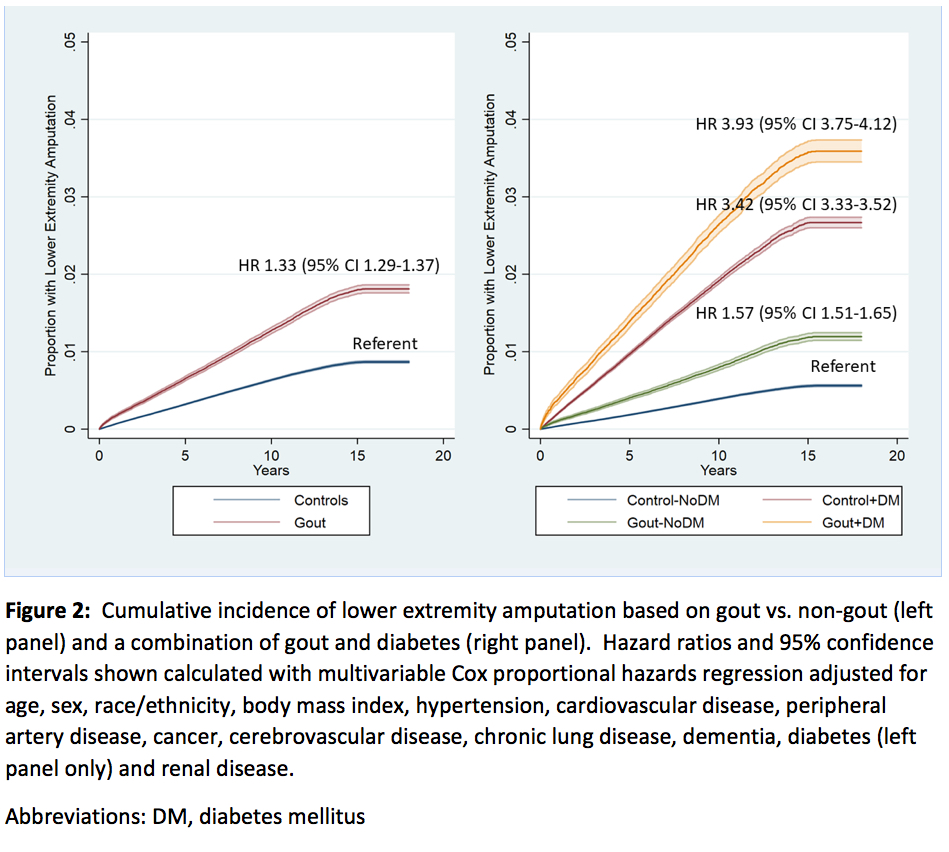Session Information
Date: Sunday, November 7, 2021
Title: Metabolic & Crystal Arthropathies – Basic & Clinical Science Poster I (0660–0682)
Session Type: Poster Session B
Session Time: 8:30AM-10:30AM
Background/Purpose: Gout is associated with a number of comorbidities such as diabetes that are known risk factors for peripheral vascular disease. These comorbidities along with manifestations that mimic infection could place patients with gout at an increased risk of undergoing lower extremity amputation (LEA). The goal of this study was to determine if patients with gout are at a higher risk of undergoing LEA and to determine if this risk is independent of diabetes and other comorbidities.
Methods: We performed a retrospective matched cohort study using national Veterans Health Administrative (VHA) data from January 1999 to July 2015. Patients with gout were identified by the presence of ≥2 ICD9 codes (274.X). Gout patients were matched up to 1:10 by birth year, sex, and calendar year to patients without gout. Patients receiving LEA prior to the index date were excluded. LEA was defined using ICD9 procedure and common procedural terminology (CPT) codes and categorized as toe, transmetatarsal, below-the-knee, or above-the-knee. Diabetes and other comorbidities (e.g., peripheral vascular disease) were identified using ICD9 codes. Patients were followed until LEA or censoring due to death or end-of-study. Non-gout comparators developing gout later could “switch over”, contributing at-risk time for gout after matching to 10 new controls. Associations of gout with LEA were examined using multivariable Cox proportional hazards regression accounting for demographics, body mass index, and comorbidities. In secondary analyses, patients were examined in 4 groups based on the presence/absence of gout and diabetes.
Results: We identified 556,521 gout patients and 5,368,397 matched non-gout controls. Patients had a mean age of 67 years and were predominantly male (99%). There were 4,970 LEAs over 4.2 million pt-yrs of follow-up in patients with gout and 24,583 LEAs over 40 million patient-years of follow-up in controls. The risk of LEA (overall and by category) in patients with gout is shown in Figure 1. After accounting for covariates, gout was associated with a significant increase in LEA risk (HR 1.33; 95% CI 1.29-1.37). This risk was highest for below-the-knee amputations (HR 1.66; 95% CI 1.46-1.90). Of other risk factors, diabetes (HR 3.23; 95% CI 3.15-3.32) was most strongly associated with LEA. Results based on dual gout and diabetes statuses are shown in Figure 2. In the absence of diabetes, patients with gout demonstrated a 1.57-fold increased risk (95% CI 1.51-1.65) of LEA. The highest risk of LEA was among patients with gout and diabetes, exceeding the risk posed by diabetes alone.
Conclusion: Patients with gout are at a 33% increased risk for undergoing LEA, with an even higher risk for below-the-knee amputations. This risk is independent of other comorbidities that have been associated with LEA including diabetes. Further research is needed to better understand the surgical indications for these procedures, whether tophi (which can mimic osteomyelitis) are associated with heightened risk, and to what degree LEA might be prevented in this patient population through enhanced diagnostics or improved gout management.
To cite this abstract in AMA style:
Soto Q, Petro A, England B, Sayles H, Helget L, Roul P, Neogi T, O'Dell J, LaMoreaux B, Mikuls T. Disappearing Digits: A National Retrospective Matched Cohort Study Examining the Risk of Lower Extremity Amputation in Gout [abstract]. Arthritis Rheumatol. 2021; 73 (suppl 9). https://acrabstracts.org/abstract/disappearing-digits-a-national-retrospective-matched-cohort-study-examining-the-risk-of-lower-extremity-amputation-in-gout/. Accessed .« Back to ACR Convergence 2021
ACR Meeting Abstracts - https://acrabstracts.org/abstract/disappearing-digits-a-national-retrospective-matched-cohort-study-examining-the-risk-of-lower-extremity-amputation-in-gout/


